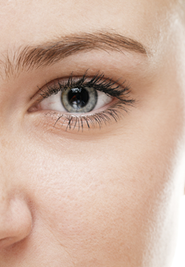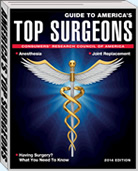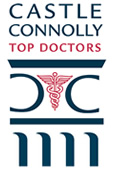Eyelid Surgery (Blepharoplasty)
 Eyelid surgery, or blepharoplasty, is utilized to give a more refreshed and youthful look to the eyes. As we age we develop extra skin in both the upper and lower eyelids. This is often associated with areas of bulging fat pads that can occur in both eyelids but are mostly noted in the lower eyelids. In addition a brow lift and / or cheek lift may be used in combination to give a rejuvenation to the Eyelid Surgery | Blepharoplasty | Maryland | Washington DC upper one-half of the face. In eyelid surgery the goal is to remove the excess skin, tighten the appearance of the eyelids, as well as to remove or to alter the bulging fat pads. Sometimes the fat pads of the lower eyelid are redraped over the cheek to help treat the depression that occurs there as the cheek tissues descend with age. In addition some patients will request a more exotic look to their eyes. This can be achieved by slightly elevating the outer angle.
Eyelid surgery, or blepharoplasty, is utilized to give a more refreshed and youthful look to the eyes. As we age we develop extra skin in both the upper and lower eyelids. This is often associated with areas of bulging fat pads that can occur in both eyelids but are mostly noted in the lower eyelids. In addition a brow lift and / or cheek lift may be used in combination to give a rejuvenation to the Eyelid Surgery | Blepharoplasty | Maryland | Washington DC upper one-half of the face. In eyelid surgery the goal is to remove the excess skin, tighten the appearance of the eyelids, as well as to remove or to alter the bulging fat pads. Sometimes the fat pads of the lower eyelid are redraped over the cheek to help treat the depression that occurs there as the cheek tissues descend with age. In addition some patients will request a more exotic look to their eyes. This can be achieved by slightly elevating the outer angle.
Routine upper and lower eyelid surgery is performed as an outpatient. Most patients will be up and about the following day. Although one may feel like working at home in as little as two days after the surgery, they will usually wait at least five to seven days to return to work or other public places. The sutures are removed at three to four days and makeup can be applied one day following that. Most of the associated swelling will resolve within two weeks. Interestingly, eyelid surgery results usually last longer than other facial rejuvenate procedures; and for this reason, these procedures are rarely repeated.
What can eyelid surgery do for me?
Blepharoplasty is ideal for the correction of:
- Loose, sagging and/or folded upper eyelids that may limit vision
- Puffy fat deposits in the upper eyelids
- Under-eye bags
- Sagging lower eyelids that may show the white of the eyes below the iris
- Excess skin in the lower eyelids
- Fine wrinkles in the lower eyelids
What won't blepharoplasty correct?
Blepharoplasty cannot raise the eyebrows or reduce the appearance of deep wrinkles, crow’s feet or dark circles under the eyes. However, eyelid lifts can be combined with other procedures such as brow lifts, BOTOX® Cosmetic treatments and laser procedures to achieve these results.
Am I a good candidate for an eyelid lift?
The best candidates for blepharoplasty:
- Are generally healthy
- Do not smoke
- Have realistic expectations
- Do not have any serious eye conditions
Dr. Person will talk to you about whether you are a good candidate for eyelid surgery.
How is a blepharoplasty performed?
Eyelid surgery is usually performed in an office, usually with local anesthesia and IV sedation. The procedure can take less than 45 minutes.
Incisions are made along the eyelids in inconspicuous places: in the natural creases of the upper lids for upper eyelid blepharoplasty and just below the lash line on the lower lids for lower eyelid blepharoplasty. If no skin needs to be removed, the surgeon will likely perform a transconjunctival blepharoplasty, where the incision is made inside the lower eyelid and there are no visible scars.
In all cases, the surgeon then removes excess skin from the eyelids using a scalpel, laser or radiofrequency (RF) tool. Fat may be removed as well. He then closes the incisions with fine sutures, tissue glue or surgical tape.
What is recovery from eyelid surgery like?
Bruising, swelling and a sense of tightness in the eyelids are common after eyelid surgery. These should subside within 2-4 weeks. Most patients resume activities in 3-5 days, when non-absorbable stitches are removed, and return to work in about 10 days. By one to two months after surgery, you should see the true results of your eyelid lift: a more awake and cheerful look around the eyes, and greater self-confidence.
Contact lenses may not be worn for two weeks. Eyes can be sensitive to light and wind and may be slightly irritated for a short while; your surgeon may prescribe eye drops and cool compresses to ease any discomfort.
What are the risks of eyelid surgery?
Complications from blepharoplasty are uncommon, but can include infection, reaction to anesthesia, dry eyes, double or blurred vision for a few days, temporary swelling of the eyelids, tiny whiteheads, and difficulty closing eyes when going to sleep. Uneven healing and scarring, and ectropion (pulling down of the lower lids) are very rare and may require surgical correction. Patients with thyroid problems, dry eye, high blood pressure, diabetes, detached retina, glaucoma or other health problems should consult with an ophthalmologist about eligibility.
To view our photo gallery of before and after examples, please click here.








If you would like more information about Eyelid Surgery (Blepharoplasty) or to schedule an appointment, feel free to fill out our convenient contact form or call us directly at 301.982.0202.